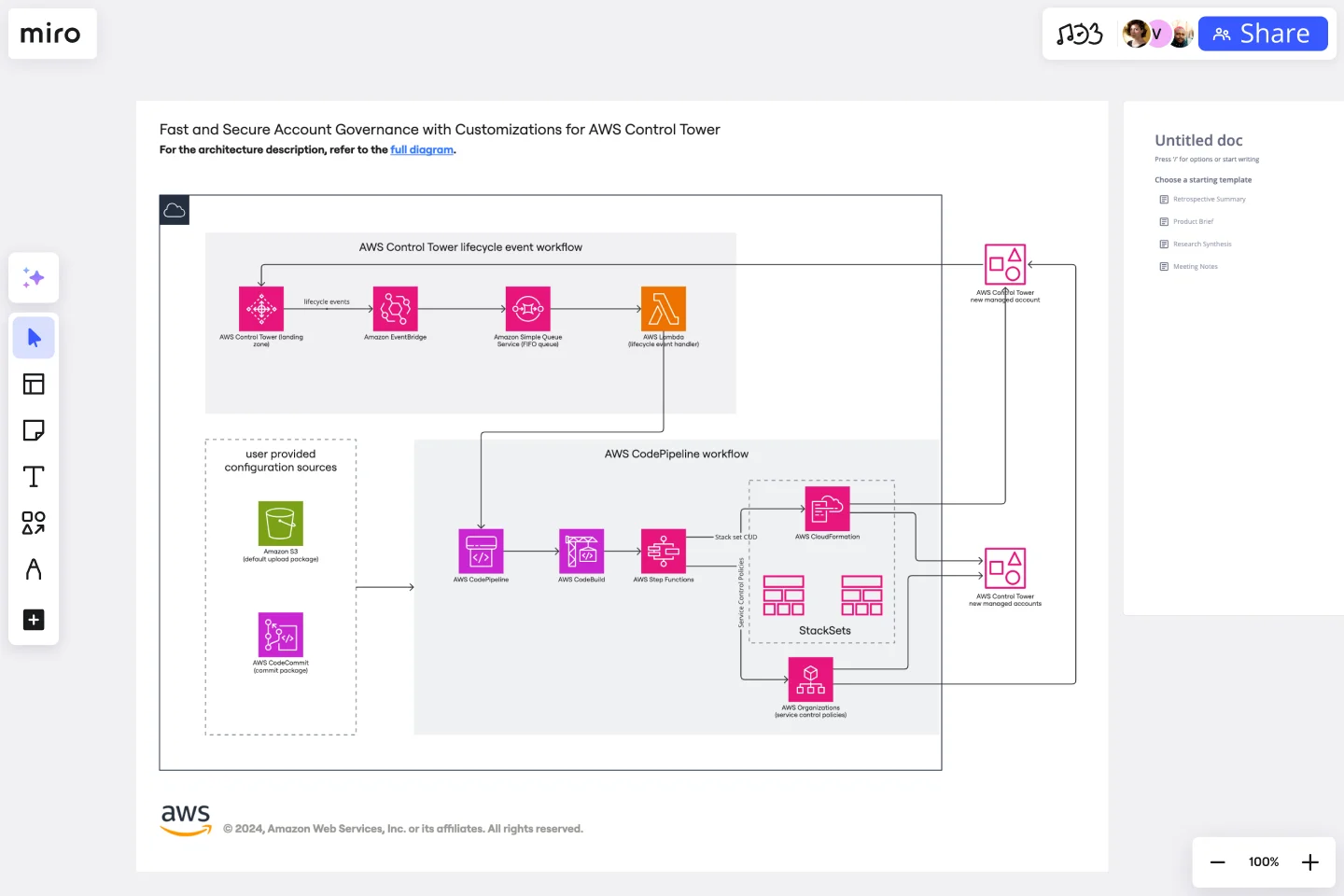AWS Control Tower Account Governance Template
Streamline the setup and management of governance across multiple AWS accounts with the AWS Control Tower Account Governance Template.
Available on Enterprise, Business, Education plans.
About the AWS Control Tower Account Governance Template
The AWS Control Tower Account Governance Template is a powerful tool designed to streamline the governance of AWS accounts, ensuring that your AWS environment is set up and managed according to best practices for security, operations, and compliance. This template is particularly useful for organizations looking to automate and enforce governance rules across multiple AWS accounts efficiently.
How to use the AWS Control Tower Account Governance Template
Customize the template: Depending on your organization's specific needs and policies, you may need to customize the template. This could involve adding, removing, or modifying certain sections to better align with your governance requirements. Miro's flexible editing tools make it easy to tailor the template to your needs.
Collaborate with your team: Miro's collaborative features allow you to work on the template with team members in real time. You can discuss changes, assign tasks, and gather feedback directly within the Miro board. This collaborative approach ensures that everyone is aligned and contributes to the governance process.
Implement governance controls: After customizing the template to your organization's needs, you can begin implementing the governance controls outlined in the template. This may involve setting up AWS Control Tower, configuring guardrails, and establishing account structures as recommended in the template.
Review and iterate: Governance is an ongoing process. Regularly review the effectiveness of your governance controls and make adjustments to the template as needed. Miro's version history feature allows you to track changes over time and revert to previous versions if necessary.
Why use the AWS Control Tower Account Governance Template
Efficiency: Automates and simplifies the process of setting up and managing governance across multiple AWS accounts.
Best practices: Ensures that your AWS environment is aligned with AWS best practices for security, operations, and compliance.
Collaboration: Facilitates collaboration among team members, allowing for a unified approach to governance.
Customization: Offers the flexibility to tailor governance controls and policies to fit the unique requirements of your organization, ensuring that the AWS environment aligns with your specific security, compliance, and operational standards.
Visibility and control: Provides a centralized view of your AWS environment, making it easier to monitor compliance with governance policies and identify issues before they become problems.
Scalability: As your organization grows, the template scales with you, facilitating the management of an increasing number of AWS accounts without compromising on governance standards.
Security: Enhances the security posture of your AWS environment by implementing best practices and guardrails that protect your resources and data.
Compliance: Helps ensure that your AWS environment complies with internal policies and external regulations, reducing the risk of non-compliance penalties.
Cost management: By enforcing governance policies, you can avoid unnecessary costs associated with over-provisioned resources and inefficient configurations.
Get started with this template right now. Available on Enterprise, Business, Education plans.
Cisco Network Diagram Template
Works best for:
Software Development, Diagrams
Cisco offers data center and access networking solutions built for scale with industry-leading automation, programmability, and real-time visibility. The Cisco Data Network Diagram uses Cisco elements to show the network design of Cisco Data Networks visually.
Instance Scheduler on AWS Template
Works best for:
AWS
The Instance Scheduler on AWS template is a strategic tool designed to enhance the efficiency and cost-effectiveness of managing AWS resources. It serves as a guide for automating the scheduling of Amazon EC2 and Amazon RDS instances, ensuring that these resources are operational only when necessary. This approach not only simplifies the management of instance schedules but also significantly reduces cloud computing costs by avoiding unnecessary runtime.
UML Diagram Template
Works best for:
Diagrams, Software Development
Originally used as a modeling language in software engineering, UML has become a popular approach to application structures and documenting software. UML stands for Unified Modeling Language, and you can use it to model business processes and workflows. Like flowcharts, UML diagrams can provide your organization with a standardized method of mapping out step-by-step processes. They allow your team to easily view the relationships between systems and tasks. UML diagrams are an effective tool that can help you bring new employees up to speed, create documentation, organize your workplace and team, and streamline your projects.
UML Sequence Deployment Pipeline Template
Works best for:
UML
The UML Sequence Deployment Pipeline Template in Miro visually maps the sequence of steps in an automated deployment pipeline, helping teams in software development and deployment. It helps identify bottlenecks, standardizes the deployment process, and facilitates new member onboarding for continuous improvement.
Kubernetes Application Template
Works best for:
Software Development, Diagrams
Use the Kubernetes Application template to manage enterprise-ready containerized applications better. You can now get your team more agile when dealing with portability, licensing, and consolidated billing. The Kubernetes Application template allows you to run deployments anywhere, facilitating the management of your applications. Try it out and see if it’s the best fit for you and your team.
SIPOC Template
Works best for:
Agile Methodology, Strategic Planning, Mapping
A SIPOC diagram maps a process at a high level by identifying the potential gaps between suppliers and input specifications and between customers and output specifications. SIPOC identifies feedback and feed-forward loops between customers, suppliers, and the processes and jump-starts the team to think in terms of cause and effect.
